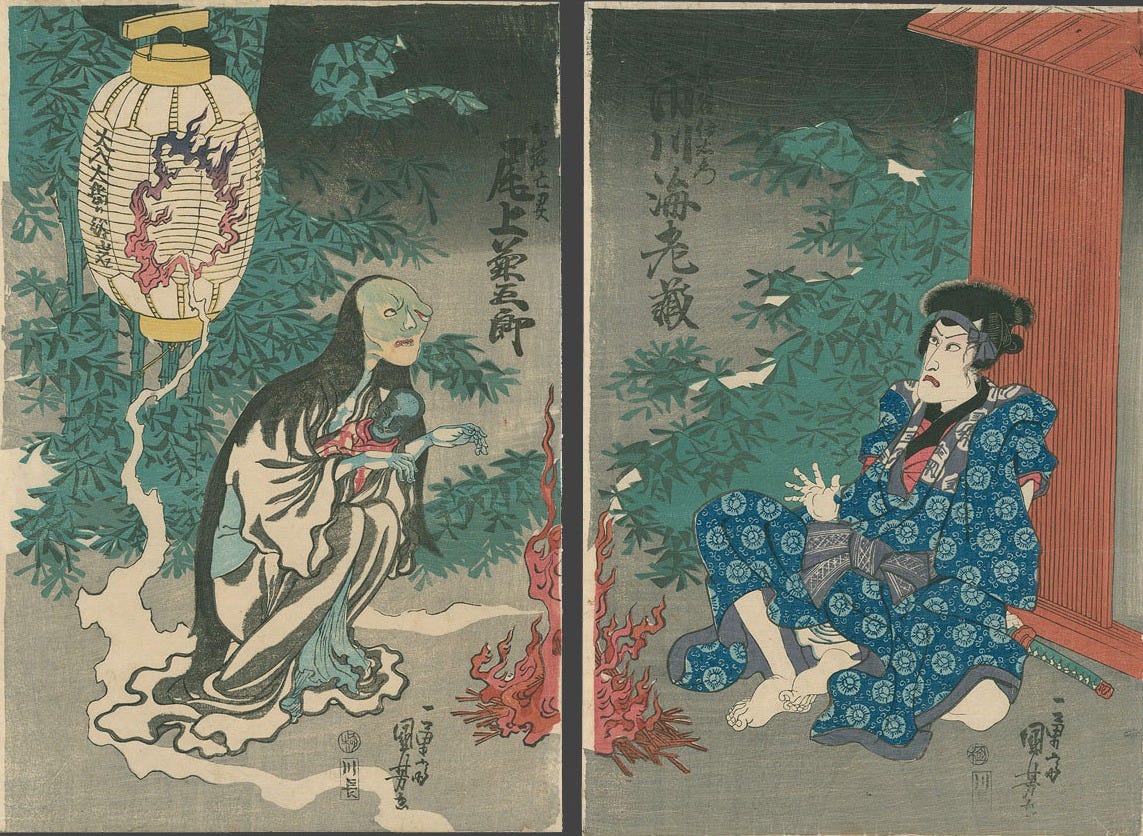The Tale of Oiwa’s Ghost and the Quiet Horror of Betrayal
Tai Kato’s 1961 adaptation turns one of Japan’s most enduring ghost stories into a haunting blend of folklore, violence, and devastating sorrow.
When it comes to Japanese titles, the folks at Radiance Films consistently leave me in a state of cinematic euphoria. I turn to Radiance for the deeper cuts, always thrilled to expand my knowledge and realize how much more there is to uncover. With their release of 1961’s The Tale of Oiwa’s Ghost late last month, I’ve found yet another filmmaker whose work I’m now delighted to explore in greater detail: Tai Kato. A director perhaps best known for his crime and action films, Kato’s take on one of Japan’s most enduring ghost legends shows remarkable depth and visual poetry.
The story itself, Yotsuya Kaidan, is centuries old. For 200 years, it has been depicted in paintings, kabuki, film, and television, with the original stage play premiering in 1825. It even helped shape the J-horrors we know today, inspiring everything from Ringu to (loosely, at least) Ju-On (The Grudge).
This story has been adapted so often that Radiance included a seven-minute visual essay by Lindsay Nelson in their release, which highlights various interpretations of the ghost story and the visual similarities between them all.
What’s compelling here is that Yotsuya Kaidan is a spin-off of the legend of The 47 Ronin. Based on true events that occurred in 1703, this Japanese legend recounts the story of a group of samurai avenging their master, feudal lord Asano Naganori, after he is humiliated by an influential court official. Although Naganori tries to fight back, his superiors force him to commit seppuku. As a result, the group of samurai — the 47 Ronin — decide to avenge their master by going after the man responsible: Lord Kira. Then, all 47 take their own lives in the same ritual.
The connection to Yotsuya Kaidan lies in the fact that the fictional antihero of the spin-off, the samurai Iemon, was once a part of this clan. But unlike the 47 who committed themselves to honor and revenge, Iemon refused to take part. His act of cowardice becomes his downfall. With no purpose left, he descends into a state of greed and manipulation. In a twist of almost cosmic irony, the woman he betrays his family for, Oume, is the granddaughter of Lord Kira. Fate comes full circle, and the past refuses to stay buried. Learning about all of this backstory and connection only elevated The Tale of Oiwa’s Ghost for me.
In Kato’s version, atmosphere is everything. Although the spectral element doesn’t arrive until late in the film, the atmosphere feels haunted from the very start. The dense fog never lets up, drifting like a living thing; the moon hangs heavy above murky, swampy landscapes. Even before a ghost appears, this world feels cursed.
All of this to say, The Tale of Oiwa’s Ghost doesn’t feel like much of a ghost story for the majority of its runtime. Instead, it leans into domestic tragedy. Still, the horror is ever-present through Iemon’s greed and suffocating abuse. One of the most haunting sequences comes not from a ghost, but from a moment of quiet, desperate devastation. After one brutal attack, Oiwa crawls to her crying child and softly sings a lullaby. We watch from afar as the camera frames her swallowed by the empty space around her, allowing for the tragedy to linger within.
When the film finally shifts into the realm of the supernatural, it’s a crescendo of violence, filled with vicious bursts and frantic handheld camerawork. Kato’s visual style is breathtaking throughout. Low angles (sometimes so low that the crew had to dig holes into the ground to capture them) create an overwhelming sense of scale. The film’s theatricality is in conversation with kabuki, evident in the way space is utilized and characters move within it, as well as in the way shadows stretch like stage curtains, foreshadowing the vengeance to come.
As haunting as it is, The Tale of Oiwa’s Ghost holds a quiet tenderness beneath the horror. Even in grief, love refuses to disappear, entwined in the pain, yet still present.
I’m so glad to own Radiance’s beautiful restoration of this film. The special features help enrich the tale with background information, only further contextualizing the impact Yotsuya Kaidan has had on Japanese horror tales throughout countless decades.
For those drawn to the quieter tragedies within ghost stories, this version is a tale worth visiting.







